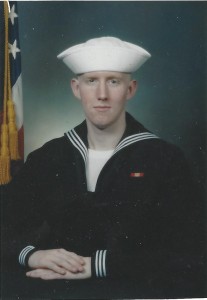 Guy Allen Brent Kelley (1988-)
Guy Allen Brent Kelley (1988-)
My nephew joined the navy after graduating high school. He served as a sonar technician on a submarine.
I have added/rearranged this post as new updated ethnicity estimates have become available.
When we were growing up we were told that we were “Scotch, Irish & German.” It is difficult, however, to trace back from where all my mom’s ancestors immigrated. Many were some of the first immigrants to the New World in New Netherland (New York & New Jersey) and Virginia. I have reached dead ends in some lines.
Here is a map of how many of my ancestors migrated across America, mostly on my mom’s side. (My dad’s family settled in Iowa and then moved to California where I was born.):
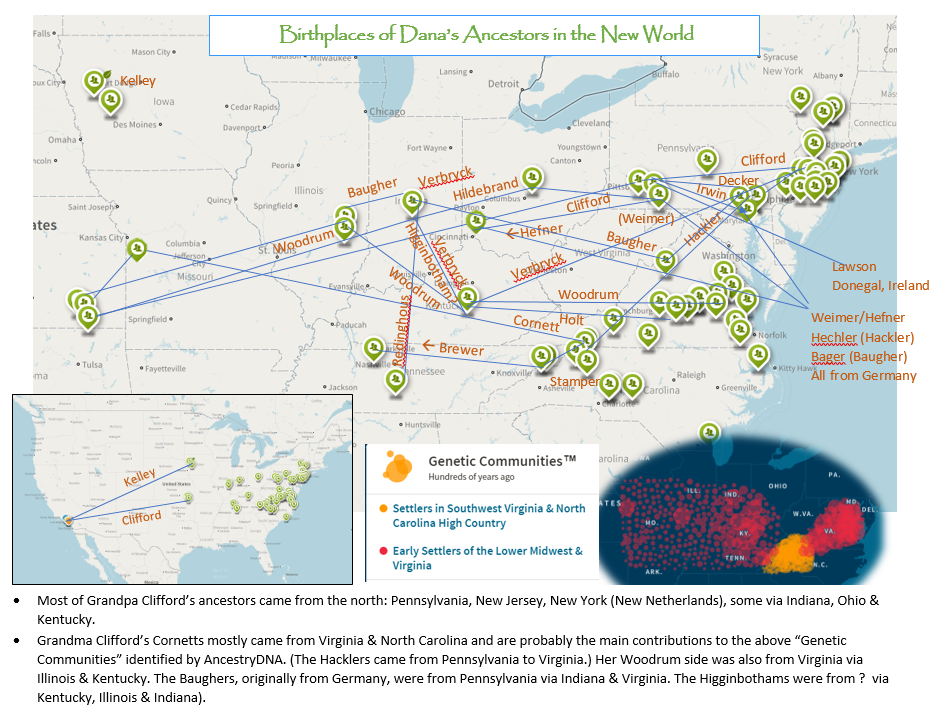
To begin, it helps to have some understanding of genetics. Although we are guaranteed to get 1/2 of our genes from our fathers and 1/2 from our mothers (actually a little more from our mothers, if you include the little extra on the X chromosome for males and mitochondrial DNA). We are likely to get 1/4 from each of our grandparents, but that can vary depending on which genes were contributed to us by our parents. So the estimated percentages, that I came up with from my tree were based on an 1/8 from great-grandparents, 1/16 from 2nd great-grandparents, 1/32 from 3rd great-grandparents, etc….
Here is an estimate for my mom based on the family tree (I mostly used Mom’s 3rd great grandparents as a basis.)
Following are new ethnicity estimates from AncestryDNA, which appear much more accurate:
Here is the new estimate from AncestryDNA for my mom, Doretta Clifford Kelley:

Versus her old estimate:
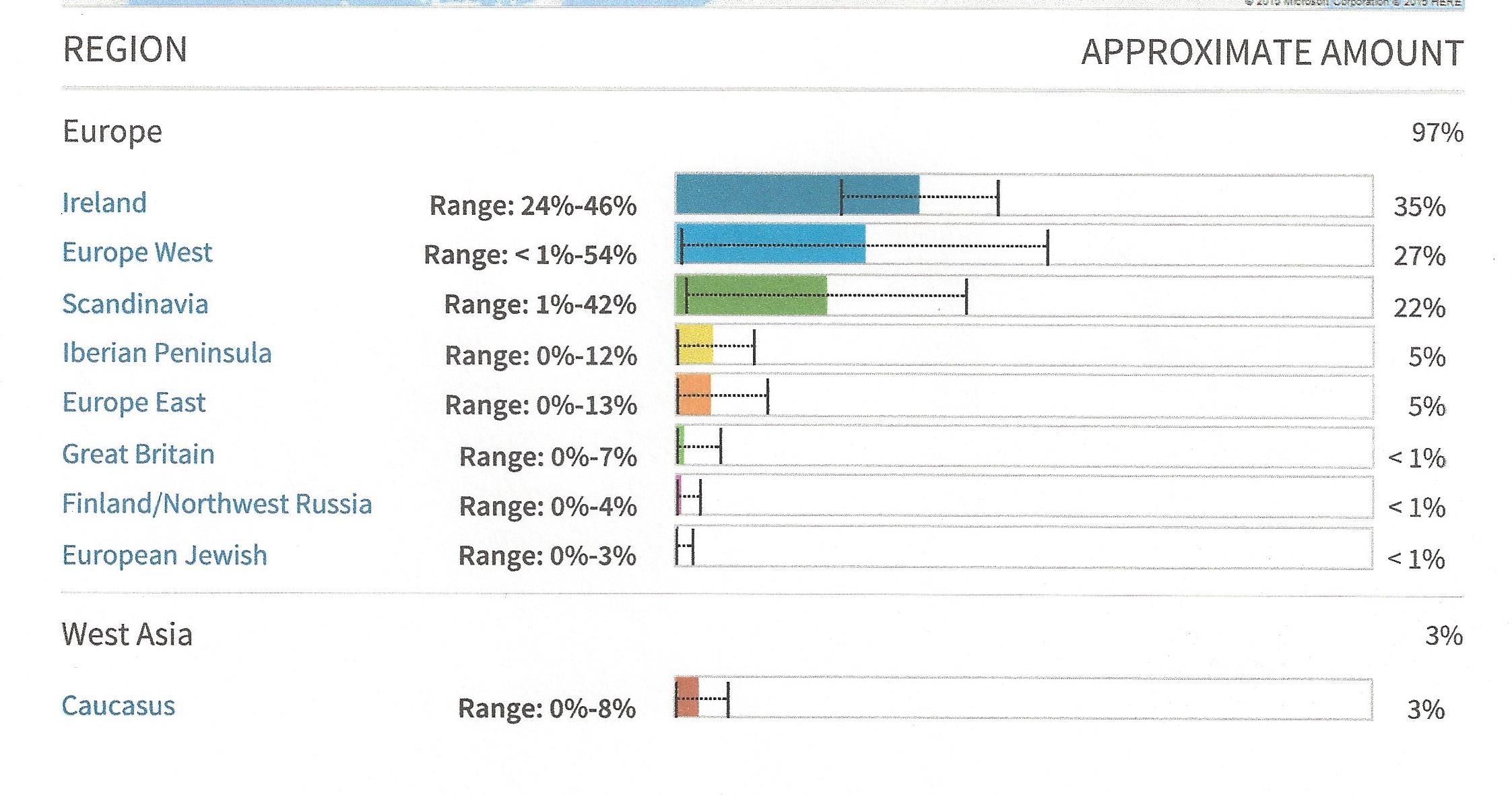
 She appears to have lost all her Irish! –And many of those odd trace ethnicities. She went to having just a trace Great Britain to 92% England, Wales, Northwestern Europe. I would have expected more German and Irish. But remember that there have been lots of migrations in Europe and many of the people of England are really French, German and Scandinavian as well as Celtic. People have been interbreeding for millennia.
She appears to have lost all her Irish! –And many of those odd trace ethnicities. She went to having just a trace Great Britain to 92% England, Wales, Northwestern Europe. I would have expected more German and Irish. But remember that there have been lots of migrations in Europe and many of the people of England are really French, German and Scandinavian as well as Celtic. People have been interbreeding for millennia.
Dana Kelley Bressette’s New Estimate:

Eric Kelley’s New Estimate:
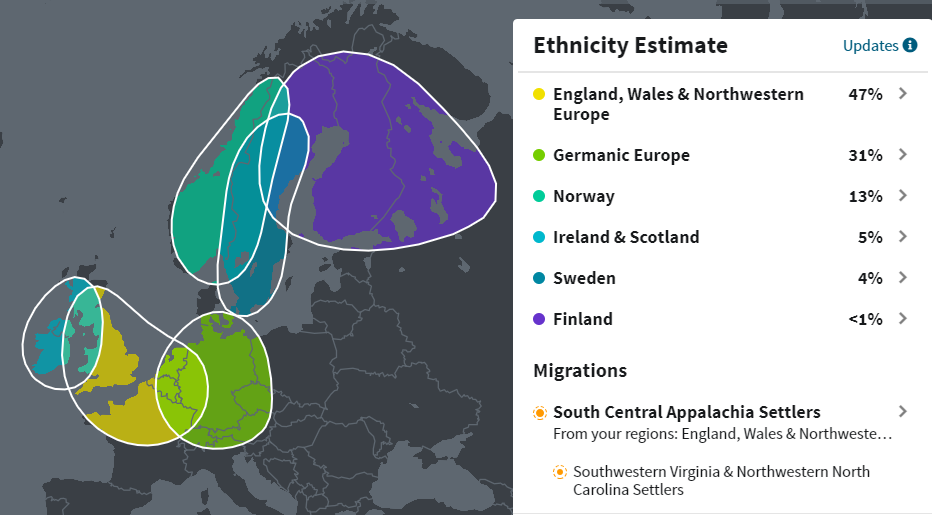
Bruce Kelley’s New Estimate:
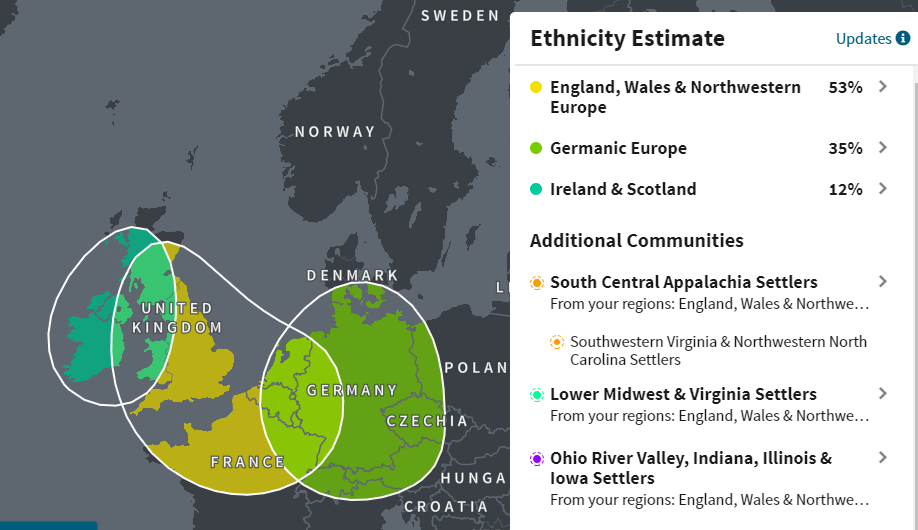
Eric appears to have gotten some Swedish and a trace of Finnish and has more Norwegian than me. Bruce did not show any Scandinavian. Bruce and I ended up with more Irish; and I got a little more English and less German than Bruce and Eric. Otherwise, we are all now more similar. Eric’s changed significantly from his previous estimate. He went from having 78% British to 47% England, etc. (which did not make sense, since mom’s previous estimate had her as < 1%!) You can see the older estimates if you scroll down to older ethnicity analyses that I had done.
If I average mine, Eric’s and Bruce’s together, I get the following estimate for my dad, Dean Kelley:
(There is an extra 2% because the math showed a -2% Finnish)
We know that all 4 of my dad’s grandparents emigrated from Europe so what we might expect would be:
So the results come out close to what we would expect.
**I still like to say my “Ethnic Center” is in the middle of the North Sea!
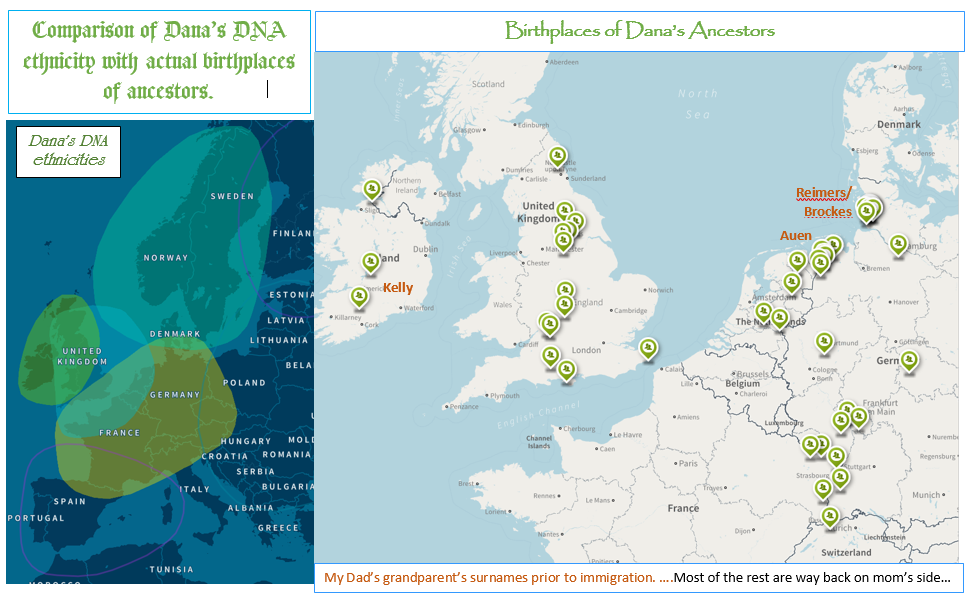
My son and both Eric’s sons and one of Bruce’s daughters also have tested with ancestryDNA.
Here is my husband, Edmund’s results compared with my son, Sky’s:
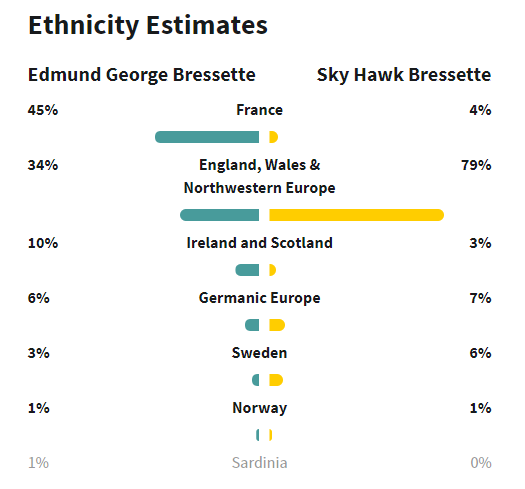
My husband’s father was all French Canadian, his maternal grandmother was all ethnic German/Alsatian. His maternal grandfather was adopted, but we know he was at least 1/4 Irish and probably at least 1/4 English on his mom’s side. The dad’s side, if I have identified him correctly, appears to go back to New England, so is likely mostly English.
If I compare what Sky’s actual results are with what would be (expected) from looking at his dad’s and mine, I get the following:
He appears to have inherited much more of the English than any of the other ethnicities. He didn’t get much of the French, German or Irish! (It does look like he got about 7% more DNA from his Grandma B than his Grandpa B, if I compare actual cM shared with his grandparents.
Here is are Eric’s son’s results compared with each other:

If I average their results and compare it with their dad, I come up with the following estimate for their mom, compare it with her (sister), who has also tested with ancestryDNA ~then average the 2:
According to her tree her grandparent’s ethnicities are as follows:
Bruce’s Daughter, Rose:
Here is a comparison of Bruce and his daughter, Rose:

Rose’s mother was born in Sweden, so we should expect a large amount of Swedish and other Scandinavian. The math does not work out very well if I try to come up with an estimate for her mother, but if I throw out the negative numbers for England (-29%) & German (-29%) and spread the rest out proportionally, I get:
It is important to note that although Bruce did not show any Norwegian, Swedish, or Finnish, Eric and I did. So he could still have had some trace amounts that could show up in his daughter and maybe could have had an additive effect in combination with her mother’s DNA?
The following chart shows the amount of DNA we share with each other, at least according to what was tested by Ancestry. The charts below show what would be expected probabilities for each relationship.
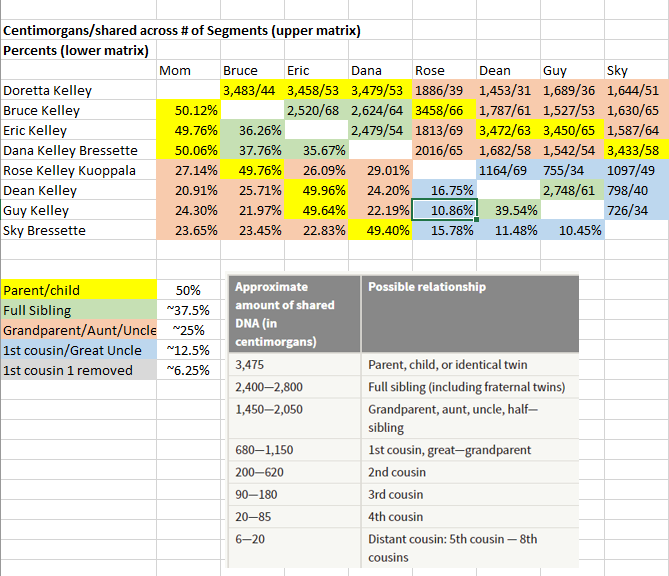
Rose seems to be the biggest outlier here. She and I share about 4% more DNA than would be expected. She also shares 3-4+% more with Dean and Sky than would be expected, and about 2% more than what would be expected with her grandmother. Dean shares about 4% less with his grandmother than would be expected, but 2% more with his brother than would be expected. Bruce shares ~3% less with Guy than would be expected and Eric shares ~2% less with Sky than would be expected.
What seems most interesting here is that many people have remarked how alike Rose and I are in looks and personality!
Old Analyses:
I have now gotten ethnicity reports from 4 different companies. The results are “all over the map,” so to speak, which indicates that this is not an exact science! I am still mostly North and Western European, although the most recent results show a lot more Eastern European and a bit more Southwestern (Iberian) European. I don’t know if it makes sense to average them..but I did..

When I had my brother, Eric tested. His ethnicity came up very different from my mom and I.
We get 50% of our nuclear DNA from each of our parents. But because of how chromosomes recombine and divide during meiosis, the contribution that we get from our grandparents can vary, even though the PROBABILITY is 25%. Therefore, each generation of more distant ancestors may contribute varying amounts to our genome.
That said, these percentages from DNA results are only estimates, median values of a range of possibilities. The width of the range depends on how heterogeneous or homogeneous that ethnic group is.
It is important to note how they come up with these estimates. They compare our DNA to a sample group of individuals from each region. It sometimes becomes difficult to distinguish distinct ethnic groups, depending on how much interbreeding occurred between groups. Those living close to trade routes or coastlines subject to invasion are likely to be genetically diverse than those who were more isolated.
The most surprising result is Eric’s large amount of Great Britain and his small amount of Europe West and Irish.

There may be several different explanations for this. It may be that our Irish Great grandfather, Andrew Kelley, had Scottish & British ancestry. His mother’s maiden name was McKettrick (Irish/Scottish, ‘son of Sitric’ from the Norse personal name Sigtryggr, for ‘true victory’ or conqueror.) His grandmother’s maiden name was Britt (an ethnic name for a Celtic-speaking Briton or a Breton).
Dad’s German great-grandparents were all from the North Sea German provinces. His Grandpa & Grandma Reimers were from Schleswig-Holstein. His Grandma Kelley (Auen) was from East Friesland. This is where the Angles and Saxons that populated England originated.
But how could Eric get 78% Great Britain when mom only showed <1%? The only thing I can guess is that there must have been some kind of synergistic expression when combined with dad’s contribution. We know that much of Grandma’s C’s ancestry was British (probably about 3/4). On Grandpa C’s side, the Cliffords, at least, were British (He was probably about 1/4 British). So mom should have come up as about 30-50% Great Britain. (See more estimates based on our family tree further down on the page).
Mom said she was always told she was “Scotch, Irish & German.” As far as I have been able to determine. She only has about 9% Scotch, 13+% Irish, & 20% German. She actually SHOULD be “English, German, Irish, Dutch, Scottish.” based on our family tree.
So much of the comparison i did earlier is thrown out the window, especially the calculations I did to try and estimate Dad’s DNA ethnicity…
OLD:
I have had DNA tests done for my mom and myself, and for Edmund and his mom. It is interesting to compare the ethnicity estimates with the actual places from where our ancestors immigrated.
It is important to note that these are just estimates. AncestryDNA “creates estimates for… genetic ethnicity by comparing…DNA to the DNA of other people who are native to a region. The AncestryDNA reference panel (version 2.0) contains 3,000 DNA samples from people in 26 global regions.”
The charts give a percentage for each ethnicity. This is a median value. The actual percentage is likely to be somewhere within the lower and upper ranges given on the chart. Some regions, such as Ireland, are more homogeneous; they have less genetic variation. Whereas Europe West & Scandinavia are more heterogeneous, and have more genetic variation. This is certainly a factor of immigration, interbreeding, and history of invasions (including rape, captive slaves, political marriages, etc. hopefully only in the distant past!), among European populations.
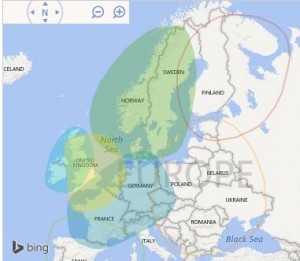
Dana Kelley Bressette
Ethnicity Estimate
____________________________________

Doretta Clifford Kelley
Ethnicity Estimate

It seems odd that mom did not show more ethnicity from Great Britain, by my figuring she should have 40% (England & Scotland), but she only shows only 0-7% in her DNA analysis. But her Irish was higher; perhaps many of her English ancestors were actually Irish? By looking at the ethnicities of our DNA matches, it seems likely that her European Jewish comes from the German side.
AncestryDNA has also matched us with many distant cousins. I have communicated and shared information with several of them. Here are the numbers of distant cousins so far that we have established one or more confirmed shared ancestors:
The Cornetts, seem to have been especially prolific!
____________________________
By comparing my mom’s estimate and my estimate, I can calculate an estimate for my dad, Dean Kelley (I had to fudge the numbers a bit so they didn’t end up greater than 100%, the calculated numbers added up to 109%):
I was initially surprised that most of my 25% Irish came from my mom’s side. But considering that Andrew Kelley’s mother’s maiden name was McKettrick (Scottish) and his grandmother’s maiden name was Britt (British), the Great Britain estimate is not so surprising. And we all know the Scandinavian Vikings spread their genes all around Europe (as well as their captives). The Frisians were also a seafaring folk; they may be closely related to early settlers in Great Britain. (Frisian is somewhat similar to English).
My DNA cousin matches on my dad’s side only show a few confirmed shared ancestors (one Kelley, and a couple Auens). I think that it is mostly due to the fact they were more recent immigrants and they seem to have had a lower birth rate. It also depends on who becomes interested in genealogy and actually has a test done.
___________________________
Captives, Patriots, Conscientious Objectors, Loyalists, Spies
My father’s ancestors were all more recent immigrants (They came in the 1860’s & 1880’s). These are all that I have found so far on my mom’s side (Cornett’s and Clifford’s). To put it in perspective, on that side, I would have had 16-4th great grandfathers (some were too young) and 32-5th great grandfathers…etc. So there are many possibilities, some I haven’t traced back that far, and at least one was a more recent immigrant.
Charles Clifford (1730-1816), my 4th great grandfather, had been a Private in the Pennsylvania Militia, County of Westmoreland, during the Revolution.

John N. Boucher’s account of Charles Clifford’s capture by Seneca Indians in the “History of Westmoreland County, Pennsylvania,” pages 98-102:
Of the capture of Charles Clifford we have a very good account both by tradition and by various writings which confirm it. He resided on Mill Creek, a tributary of Loyalhanna, two and one-half miles northwest of Fort Ligonier. In winter time he and his family stayed in or near the fort, and in the early spring they resumed their work on their clearings. On April 27, 1779, he and two sons went to their land to do some work preparatory to planting their spring crops. When they reached the place of their work they could not find their horses which they had left there the day before to graze over-night. The boys set to clearing up the land and the father went to look for the horses. He first went up to some newly deadened timber tracts near the present town of Waterford, for there he had found them once before when they strayed away. Not finding them there he continued the search, and finally reached the Forbes road leading to the fort, perhaps between Waterford and the present town of Laughlinstown [present day Highway 30 generally follows the old Forbes Road in that area]. Still he could not find his horses, and so concluded to abandon the search and return to the fort by the road. He had gone down the road but a short distance until he was fired on by five Indians who were concealed behind a log lying by the wayside. None of the balls wounded him severely, though one of them splintered his gunstock and thus cut his face, which bled profusely, though it was only a flesh wound. The Indians ran up to him, wiped the blood from his face, and seemed very glad he was not injured. They told him he would make a good man for them, and that they would take him to Niagara. They took from him his hat, coat, vest, and shirt, allowing him to retain his trousers and shoes. One of the Indians cut away the brim from his hat and amused his fellows very much by wearing the crown. Another wore his shirt and another his vest. They gave him his coat to put on, but to this he objected unless they gave him his shirt also, saying he could not wear a coat without a shirt under it. But they did not take his suggestion kindly, and he was forced to submit, and told to hurry up as they must hasten on their journey.
On the long march they treated him much more kindly than one might expect. The whole race was superstitious, and when five of them shot at him at once and failed to kill him, they concluded that he had some power to ward off dangers and might be very useful to them. They did not tie his arms, as was their universal custom even with half-grown boys. At night he slept between two Indians, with a leather strap across his breast, the ends held firmly by two Indians lying on them. As soon as they lay down they slept, but Clifford had too many things to think of to sleep so readily. Gently he drew the one end of the strap from under the Indians by his side and sat up. The moon was shining bright, but there was an Indian on a log, whose turn it was to watch the camp and keep up the fire. The watch sat silent and motionless as a statue, but the prisoner knew he was awake and would probably make short work of him if he attempted to escape.
They had journeyed nearly north from where they captured him. At a point where now the village of Fairfield is located, they were joined by fifty-two other Indians, whose general trend was northward. The chief, Clifford said, had his head and arms covered with silver trinkets. They tore down fences to roast meat, but warily marched a mile or so away from the smoke to eat and prepare a place to rest over night. Clifford had great desire to see the other prisoners and to learn if his sons were among them. They had only one other prisoner, whose name was Peter Maharg [Mehargs]. [His name also appears on the list of Rebel Prisoner Returns.] When Clifford found him he was sitting on a log much dejected, too much so to reply to Clifford’s salutation. and sat his head down in perfect silence. As it was learned afterwards he had been taken the same day and while hunting his horses. He had seen the Indians before they saw him, and was making his escape, but his dog running ahead of him, came running back to his master as soon as he saw the Indians. To the Indian this was all that was necessary. Maharg was taken at once. They further scoured the northern part of the valley for prisoners or booty, but finding nothing that was not guarded they left on the third day for their home, which was near the boundary between Pennsylvania and New York, near the headwaters of the Allegheny River. They had thus journeyed about two hundred miles and killed but two people and secured but two prisoners. On their long march homeward they marched by daylight, but always camped an hour or so before sunset. Eight or ten of them guarded the prisoners while the others hunted through the woods. At the camp they generally all met about the same time, and the hunters generally brought in venison, turkey or smaller birds. After the evening meal they lay down after the manner of the first night.
After they crossed the Allegheny river the game became scarce, even a squirrel. All the party from then on suffered greatly from hunger. At one time for three days they had nothing to eat at all except the tender bark of young chestnut trees. This they cut with their tomahawks and offered it to their prisoners. Each of them refused, and received the consolation of ‘you fool; you die.’ They now sent out two swift Indians, who went ahead and in three days returned with some other Indians, among them some squaws, and who had beans, dried corn, and dried venison. They gave the prisoners a fair share of these provisions. The Indians then divided into two parties, and one of them took the dejected Maharg, while the other took Clifford. Maharg was treated most cruelly, most likely because he remained so morose and dejected, for this from the first disgusted them with him. They made him run the gauntlet, and pounded him so severely that he fell before he had passed the line. The beating that he received did not stop when he fell. He never recovered from it, but bore marks from it on his body when he was laid down many years afterwards in his last sleep. Running the gauntlet consisted in passing between two lines of Indians stationed about six feet apart, and the lines the same distance apart. The Indians were provided with clubs, and each had a right to hit the prisoner as he passed. If the prisoner was strong he could sometimes escaped pretty well, but it was at best a most painful and dangerous ordeal.
Clifford had been from the first under an Indian who claimed him as his servant. After he had become somewhat accustomed to traveling without a shirt, his Indian gave him a shirt and hat. The shirt was covered with blood and had two bullet holes in it, and was probably taken from one of the men whom they had killed. Before he was taken prisoner, Clifford while working among the bushes had badly snagged his foot, and this without care became very painful, and the long marches had brought about inflammation and swelling. On showing it to his particular Indian guardian, he examined it very carefully and then went to a wild cherry tree with his tomahawk and procured some of the inner bark. This he boiled in a small pot and made syrup with which he bathed the foot, and after laying the boiled bark on the wound bound it up with pieces of a shirt. It very rapidly reduced the swelling and allayed the pain.
They kept Clifford six weeks and then delivered him to the British at Montreal. He learned much about their customs and curious manners, and never failed to interest his hearers by a narration of his experiences and observations among them. He saw four prisoners running the gauntlet, one of whom was killed. At another time, when a horse had kicked a boy, the animal was at once shot by the father of the lad, and the Indians ate the meat, which they thought delicious.
At Montreal [actually at Fort Chambly, which at that time was about 20 miles east of Montreal, Quebec, on the Richelieu River, a tributary of the St. Lawrence River] he grew in favor with the officers of the garrison and fared much better than most prisoners. He procured from one officer a pocket compass which he gave to a prisoner named James Flock, who escaped, and by the aid of the compass, made his way back to Westmoreland county through an almost endless wilderness, finally arriving at his home long after his friends had given him up for dead. Clifford was in Montreal two years and a half when he was exchanged. He then made his way back to Ligonier valley, having been gone three years.240 [See end note #240 for an interesting addendum to Charles returning home.]
Charles lived to be an old man and was respected by all who knew him. He is buried in the old Fort Palmer cemetery, one of the oldest graveyards in the county. He died in 1816. He was a soldier of the Revolution.
William Verbryck (1737-1824), my 4th great grandfather:
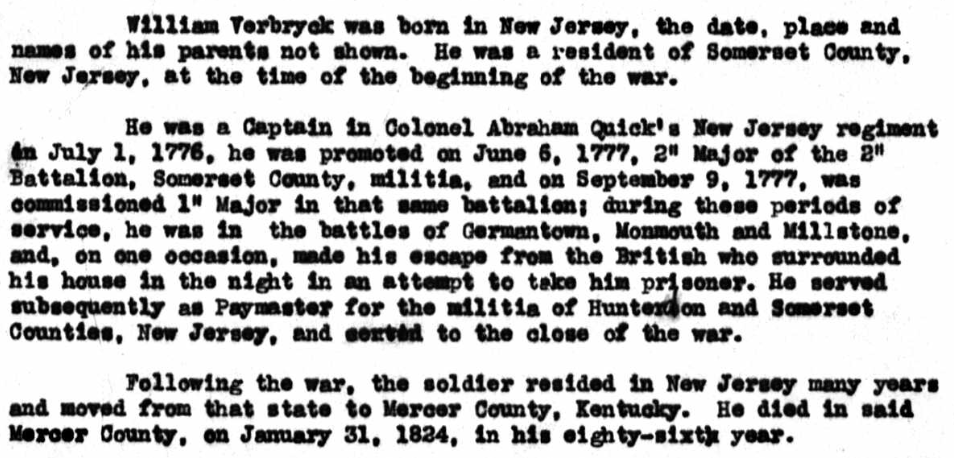
Dirck (Derrick) Low (1717-1802), my 5th great grandfather:

Solomon (Zalomon) Decker (1722-78), my 6th great grandfather– a patriot giving information to American soldiers regarding Tories and Indians. He was born and died in New York.
Abraham Hildebrand (1748-1833), my 4th great grandfather:
Judge Abraham Hildebrand was a German Baptist/Dunkard. It is guessed that Judge Abraham understood German as he bought his land (1776) Conestoga Twp. Lancaster Co., PA from Johannes Neitig witnessed by George Graff; the last two signed in German. The deed was written in English. We know that Judge Abraham could read and write English by the later deeds he signed and by his capacity as judge.
The 1777 non-associators record meant Judge Hildebrand was not in the Revolutionary War and chose to be non-associated. This agrees with his religious beliefs as a Dunkard – a Peace church. He was living in Lampeter Twp, Lancaster Co., Pa in 1777.
George Weimer ( 1762-1826), my 4th great grandfather–This appears to only be a reference to a book in the Pennsylvania Archives in which he was listed and where he was buried:

John Dewatt Weimer (1740 –1831), my 5th great grandfather, George Weimer’s father. He is the one I had discovered had been listed with “Insuffient clothing” at Valley Forge. His name is sometimes recorded as Wimmer, Wymer or Wemmer. “According to other researchers John’s Company marched on Phildelphia, in protest, over not being paid in over a year. Along the way they were intercepted by a British detachment that offered them twice the pay if they would come over to the British side. The Company refused.”
“Brothers John, Frederick, and Martin Weimer emigrated from Dortmund, Germany in 1760. They landed in Baltimore, Maryland, and later settled in Pennsylvania. All three were Revolutionary War soldiers…He served as a corporal in Captain John Riley’s Co., Third Pennsylvania Continental Line in 1778-79 which was at Valley Forge with George Washington. After the Revolution, John, his wife Susanna (born 5-7-1741, died 1-27-1831) and their family settled in Somerset County where he was granted 336 acres of bounty land in Milford Township. He received title to his land on Feb. 26, 1788 and named it Prospect Hill.”–Taken from page 177 of “Down the Road of Our Past” Book III Rockwood Area historical & Genealogical Society

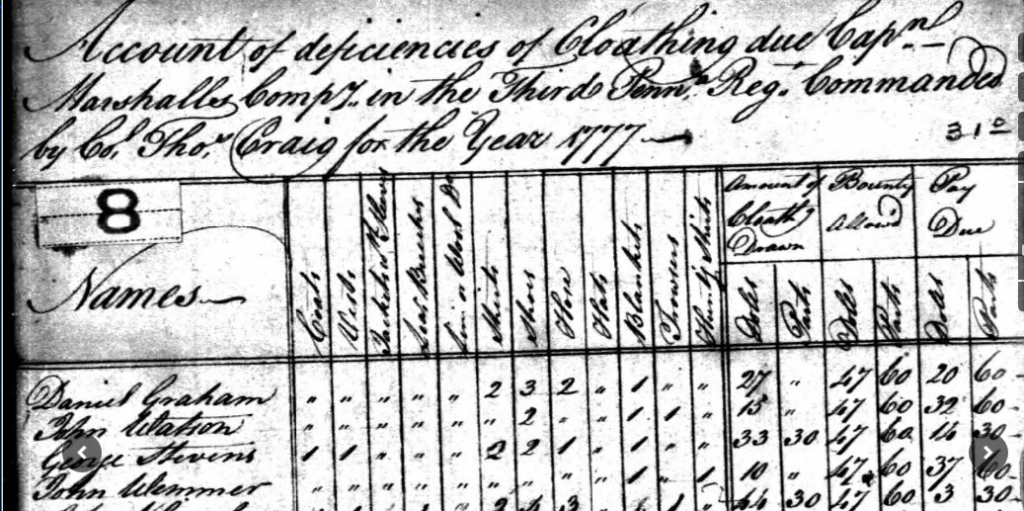
David Cornutt (1750-1847), my 5th great grandfather and probably his brother in Grayson County, Virginia:

Phillip Russell, Sr. (1745-1792), my 6th great grandfather appears to have been a Loyalist:
According to the work of Ms. Linda Cuff-Cornett, Philip Russell, Sr., was the son of William Russell, Jr., and Rebecca Louise Witherden. (Presumably, they were also the parents of the other Russell brothers, Samuel and William.) She further states that William Russell, Jr., son of Lord William Russell, Sr., was born May 29, 1721, in County Kent, England and died in 1784 in Surry County, Virginia. Evidently, William, Jr., emigrated to Virginia and Philip, Sr., was born in Surry County.
It is almost certain that the Russell brothers [Phillip and Samuel] were Loyalists during the Revolutionary War. (This should not be surprising since during the American Revolution, as in any civil war, families were often divided in their loyalties) At this time, they appear to have been living in northwestern North Carolina. This presumption is supported by records of the County Court of Wilkes County, North Carolina, which indicate that Philip Russell was ordered into the custody of the county sheriff in June of 1778 and was present in insolvent’s court (either as insolvent or as a committee member) on March 5, 1779. Moreover, it is well known from contemporary sources that many of the inhabitants of this region were sympathetic to the Crown. Furthermore, the presumption that Philip and Samuel Russell were Tories is further supported by the work of Murtie June Clark in Loyalists in the Southern Campaign in the Revolutionary War, which is cited by Shirley Ramos and Patricia Kratz, in which Private Philip Russell is listed as having been a member of Captain John Wormley’s Company of the Royal North Carolina Regiment between October 24 and December 24, 1781. Apparently, he was captured by colonial forces since it is indicated elsewhere that he was held as a prisoner of war by the rebels. In addition, Private Samuel Russell was listed in the pay abstract for Colonel Robert Ballingall’s Regiment appearing in a Certification for Service of the Colleton County, South Carolina, Militia. In any case, following the Revolutionary War, Philip Russell, Sr., along with his brother, Samuel, evidently settled in southwestern Virginia, in the area later organized as Grayson County. There they established families although, perhaps, they may have already married in either North Carolina or Virginia. According to Ramos and Kratz, a record exists which indicates that Philip Russell, Sr., died without property in Wythe County, Virginia, on January 23, 1792. (Grayson County was formally established by the Virginia General Assembly on November 7, 1792, from a part of Wythe County.) In contrast, other researchers indicate that he subsequently lived in Grayson County and died about 1807. However, there is no evidence from tax lists or other civil records that Philip Russell, Sr., and his son Philip, Jr., were both alive in Grayson County during the first decade of the nineteeth century. Therefore, the earlier date seems more likely. Moreover, the clear implication that Philip, Sr., was a pauper at the time of his death is, perhaps, consistent with confiscation of his property by victorious opponents of his Loyalist sympathies.
Paul Patrick (1730-1799), my 7th great grandfather:
The American Militia and Regulars company of Capt Paul Patrick in June 1780 belonged to the Regiment of Col. Elisha Isaacs.
They rendezvoused at Hamblins Old Store and joined General Rutherford at Salisbury and then joined the main army under General Gates at the mouth of Rocky River.
At this River they had a battle with the British and the Tories.
The army then marched to the road that leads from North Carolina to Camden and was in another battle with the British and Tories. General Gates was defeated in this battle.
Jonathan Stamper Sr. (1719-1799), my 6th great grandfather:
Jonathan was Surrey County [Virginia] Constable. During the American Revolution, he supplied the American forces with horses and provisions. Cited from Find a Grave
Edmund Hodges (1709-1782), my 6th Great Grandfather.
-furnished supplies for the soldiers during the Revolutionary War. (Virginia)
William Woodrum Jr. (1759-1841), my 4th great grandfather.
William fought in the Rev. War and as a private in David Caldwell’s Batt’s Cav Ky. Vols . 1793 and apparently deserted. Later he returned as a private in Huston’s Battalion Mounted. Ky. Vols 1794 and transferred to “Arnold’s Spies” in Price’s Battalion mounted Ky. Vols 1794.
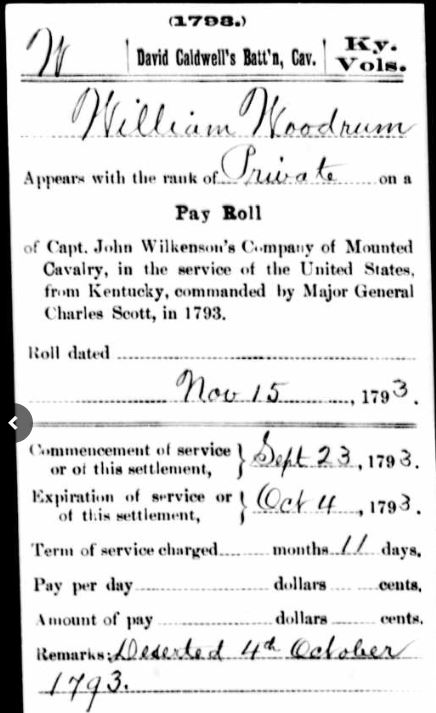
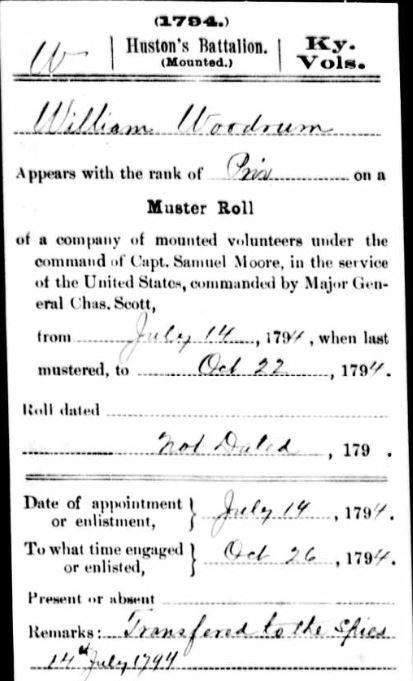

His Father-in-law:
John Jackson (1739-1821), my 5th great grandfather may have been a private in Adair’s Regiment under the command of Capt. Robert Floyd. He also may have served for 37 days in 1873 then 195 days in 1784 in John Caldwell’s Battalion in 1874 under Capt. James Thomas. There is another John Jackson that was Killed in action 10 Aug 1794 in Conn’s Battalion. Since it is a fairly common name, it is difficult to tell for sure.
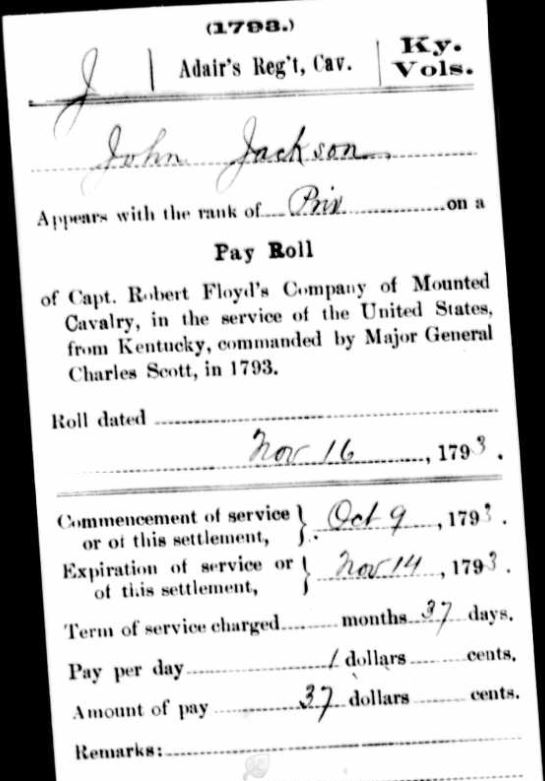
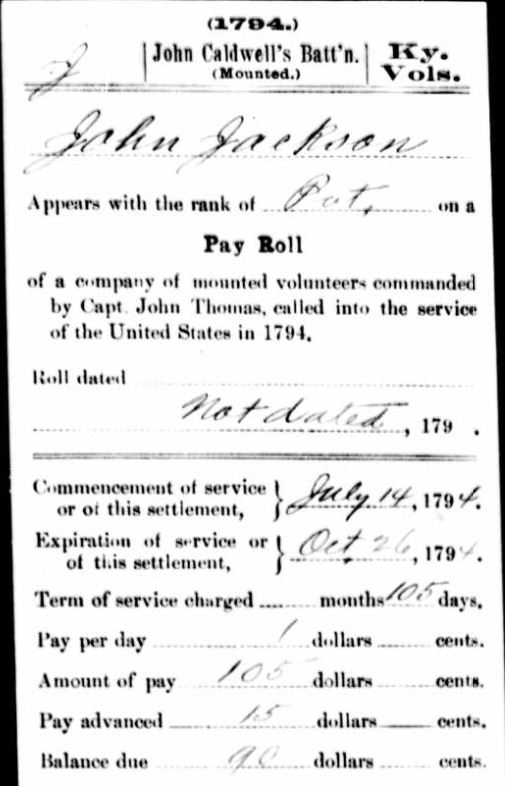
John Jacob Baugher (1760-1832), my 5th great grandfather.
“Information from Joyce Brown has John Jacob Baugher as having served with Chester County, Pennsylvania militia in Revolution.”–Thornbury Company of Militia (Pennsylvania Archives, Vol 5. pg. 795)
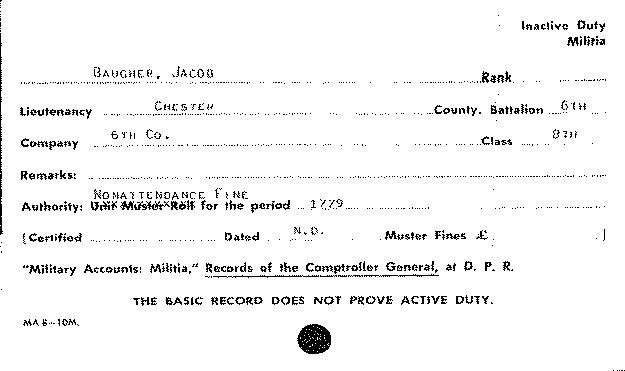
 Warren William Kelley (1914-1987)
Warren William Kelley (1914-1987)
Served in the U. S. Army
Warren left high school in his sophomore year in Holstein, Ida County, Iowa, as 6 foot 2 1/2 inch, age 17 years, 17 days. He promptly added a year to his age and enlisted in the United States Army at Fort Omaha, Omaha, Nebraska, Date Enlisted: 13 October 1931. The United States was in a deep economical depression and nearly half of American’s able-bodied men were unemployed. He had enlisted because there was no work available in or around Holstein, Iowa. Description on Military papers, Height: 6 feet 1 1/2 inches in height, Blue eyes, Hair, Light Brown, Complexion: Ruddy; Comment: His eyes were Hazel in color not Blue. (Tattoo’s on Warren’s arm list places of service: San Francisco, Philippines, China, Japan, Formosa, Guam). Also printed in the Holstein Advance Newspaper October 1931, Warren William Kelley, son of William and Marie Kelley has joined the United States Army.
On Warren’s way to the Philippines, he had a stop over in San Francisco, California, were they were just starting construction on the Golden Gate bridge. While stationed in the Philippines, Warren found himself assigned to the construction battalion responsible for building the gun emplacements and labyrinth of connecting tunnels and munitions storage areas on the Island of Corregidor. Warren was the first tram operator to take a vehicle through the completed Corregidor tunnels.
It was while they stationed him at Fort Omaha, Omaha Nebraska, that on a blind date he met, courted and married Shirley Marian Shaw on 29 Sep 1936. At the time of their marriage, Warren was a private in the United States Army
From his daughter, Sharon Kelley Knoblock
Served in the U.S. Navy as a Radarman 3c on the U.S.S. Lamson. He was Wounded in Action when his ship was hit by a Kamikaze pilot. My mom said he had flash burns even though his dungarees appeared uncharred.
Here is an account of the attack: Tin Can 367, from a book of the same name.


Enlisted in the Navy: 8 Mar 1943, Released: 1 Dec 1945 (according to U.S. Department of Affairs BIRLS File)
He trained at the U.S. Naval Training Station, Great Lakes, Illinois, 1943.
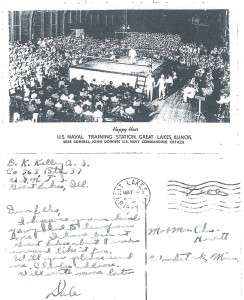
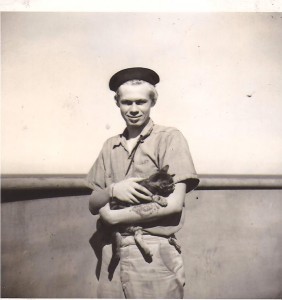
My Dad, Dean Darrell Kelley (1927-2012), joined the Merchant Marines right out of High School. He was 17, in training at the U.S. Maritime Service Training Station in Brooklyn, NY. He witnessed the celebration of VJ day on Broadway in New York City. He later served in the U.S. Army in Korea.
Many of Edmund’s Family worked at the Puget Sound Navy Shipyard in Bremerton:
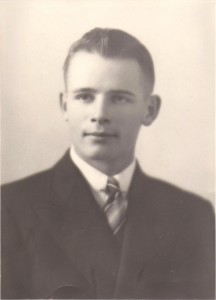 Edmund’s Grandfather, Oren Bradford Scott (1923-1990), was an Apprentice Pipefitter at the Puget Sound Naval Shipyards from 1941 to 1945. The asbestos he inhaled there ultimately contributed to his death of Mesothelioma. He was not drafted because he had a steel plate in his head after an automobile accident.
Edmund’s Grandfather, Oren Bradford Scott (1923-1990), was an Apprentice Pipefitter at the Puget Sound Naval Shipyards from 1941 to 1945. The asbestos he inhaled there ultimately contributed to his death of Mesothelioma. He was not drafted because he had a steel plate in his head after an automobile accident.
 His (adoptive) Father, Russell Irving Scott (1898-1960) also worked at the Naval Shipyards as a Crane Operator, retiring after a heart attack in 1949.
His (adoptive) Father, Russell Irving Scott (1898-1960) also worked at the Naval Shipyards as a Crane Operator, retiring after a heart attack in 1949.
 Oren’s Father-in-law, John A. Schumacher (1887-1967), also worked at the Puget Sound Naval Shipyard as an Electrician from about 1942 until he retired in the late 1950’s.
Oren’s Father-in-law, John A. Schumacher (1887-1967), also worked at the Puget Sound Naval Shipyard as an Electrician from about 1942 until he retired in the late 1950’s.
 His wife, Odelia “Tillie” Keller Schumacher (1903-1993) also worked at the Shipyards doing custodial work.
His wife, Odelia “Tillie” Keller Schumacher (1903-1993) also worked at the Shipyards doing custodial work.
Oren’s (adoptive) Uncle, Forrest Efaw Ragan (1910-1944) died in combat on the island of Guam. He was a Private First Class in the U.S. Marine Corps.
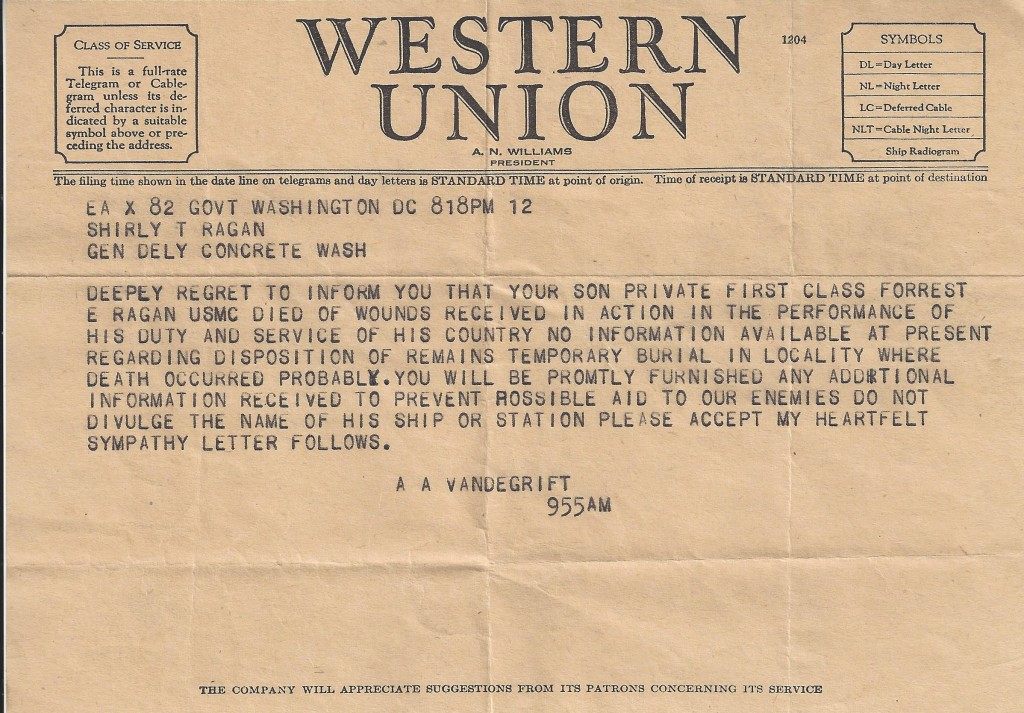
He was awarded the following awards posthumously:
He was initially buried in Army, Navy, and Marine Cemetery Number Two on Guam, Mariana Islands. He later was reinterred at the Green Hills Memorial in Burlington, Washington.
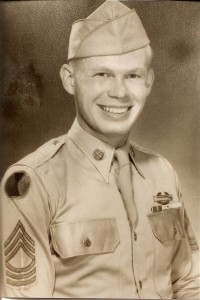 Dean Darrell Kelley (1927-2012)
Dean Darrell Kelley (1927-2012)
At Basic Training at Camp Roberts, Dean met his friends, Hal Ryerson, Dave Mellen, & Al Ogden. He went from Yokohama to Hwacheon, near the border with North Korea. In the 7th Division, 31st Infantry Regiment he was quickly promoted to Sargeant Major, earning a stripe every 30 days. He never wanted to talk much about Korea, after all, war is hell!…Once he was in a foxhole up to his neck in water, holding his rifle above his head, and bugs crawling in his hair. There was a cryptic remark in a letter from one of his school friends: “I never had an experience like your Hill 1062.” The worst part was sending young men to the front and seeing them come back in body bags. He never liked rice much after Korea, but he was proud of his service.


.
.
.
.
.
.
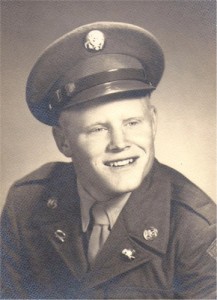 My Uncle, Jay B Clifford (1928-2004), also served in the U.S. Army in the Korean War.
My Uncle, Jay B Clifford (1928-2004), also served in the U.S. Army in the Korean War.
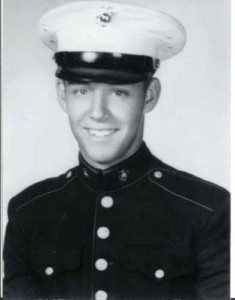 Edmund’s Uncle, Alexander R. Bressette, (1932-2006) was a Corporal in the U.S. Marine Corp.
Edmund’s Uncle, Alexander R. Bressette, (1932-2006) was a Corporal in the U.S. Marine Corp.

War of 1812
Reuben Cornutt (1790-1875) (4th great grandfather): Private, Captain Lewis Hail’s Company, Virginia Militia. Enlisted 16 Sep 1813; discharged 10 Mar 1814.
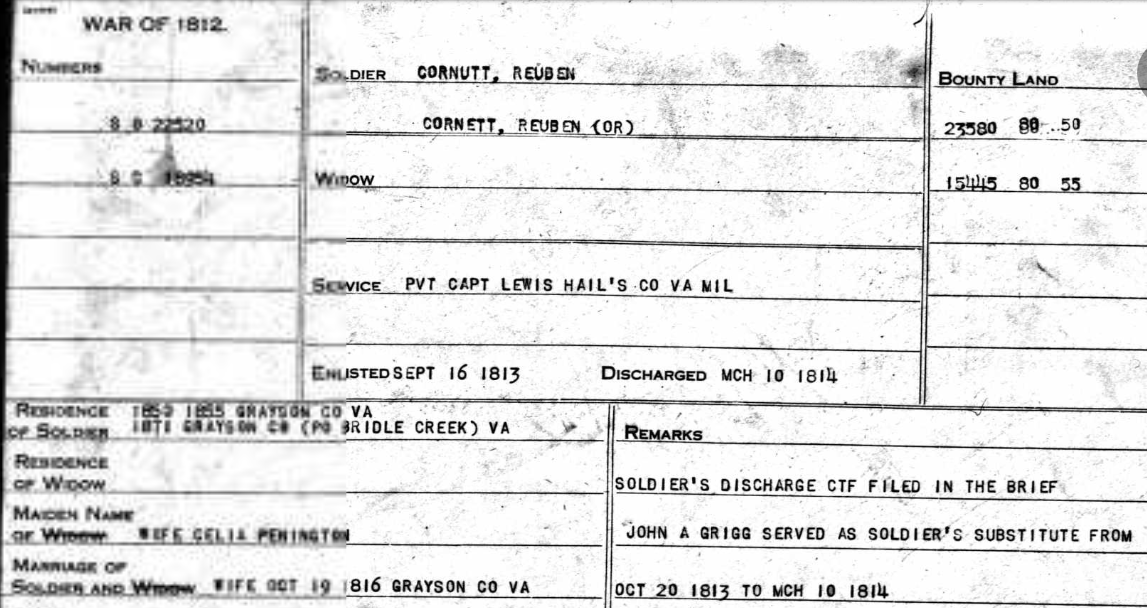
David Cornett (1750-1847), his father.

Peter Delp (1758-1841), my 5th great grandfather:
4th Regiment Virginia Militia, Private
My Civil War (1861 to 1865) Ancestors—by Dana Kelley Bressette
They are all on my mom’s side. The families settled in Kansas, not long after.
(All of my dad’s grandparents were more recent immigrants}
These are the men who would have been of age to be in the Civil War:

Hezekiah Russell Cornutt Cornett (1838-1891) (2nd great grandfather) Enlisted in the Confederate Army, 6 May 1863 in the 63rd Regiment (McMahon’s Regiment) Company C, Grayson Militia. The summer of 1863 the regiment was charged with the security of the saltworks at Saltville, VA. — AWOL June 18 1863–Deserted (or mustered out) 1 Jul 1863. —a little over a month. He was 25.
Brother against brother? I thought I once heard a story that Hezekiah fought on the opposite side of the war that his brothers fought on and he had to sneak home to visit his mother. I found this note in my records, from a correspondent: “Hezikah left when he overheard his brothers talking about hanging him for fighting for the North.” — Perhaps it was because he deserted from the Confederate Army?
 Alfred Alexander Cornutt (1818-1905), his father, enlisted as a private in the Confederate Army in Company I, Virginia 51st Infantry Regiment in 1863. He would have been 45. Reuben Cornett (1847-1898), Hezekiah’s brother, enlisted in the Union Army, Company I, 2nd West Virginia Cavalry, on June 30, 1864. He would have been 17. His other brothers were younger. His Grandfather, Reuben would have been in his 70’s (He fought in the War of 1812).
Alfred Alexander Cornutt (1818-1905), his father, enlisted as a private in the Confederate Army in Company I, Virginia 51st Infantry Regiment in 1863. He would have been 45. Reuben Cornett (1847-1898), Hezekiah’s brother, enlisted in the Union Army, Company I, 2nd West Virginia Cavalry, on June 30, 1864. He would have been 17. His other brothers were younger. His Grandfather, Reuben would have been in his 70’s (He fought in the War of 1812).
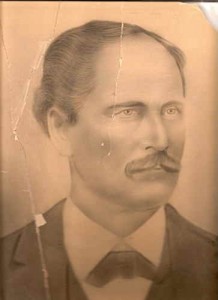 Richard Verbryck (1837-1899) (2nd great grandfather) enlisted as a Private in the Union army on 9 July 1863, Company A, 114th Infantry Regiment Indiana Mustered Out Company A, 114th Infantry Regiment Indiana on 21 Jul 1863 at Indianapolis, IN. He was 25.—Only 12 days?
Richard Verbryck (1837-1899) (2nd great grandfather) enlisted as a Private in the Union army on 9 July 1863, Company A, 114th Infantry Regiment Indiana Mustered Out Company A, 114th Infantry Regiment Indiana on 21 Jul 1863 at Indianapolis, IN. He was 25.—Only 12 days?
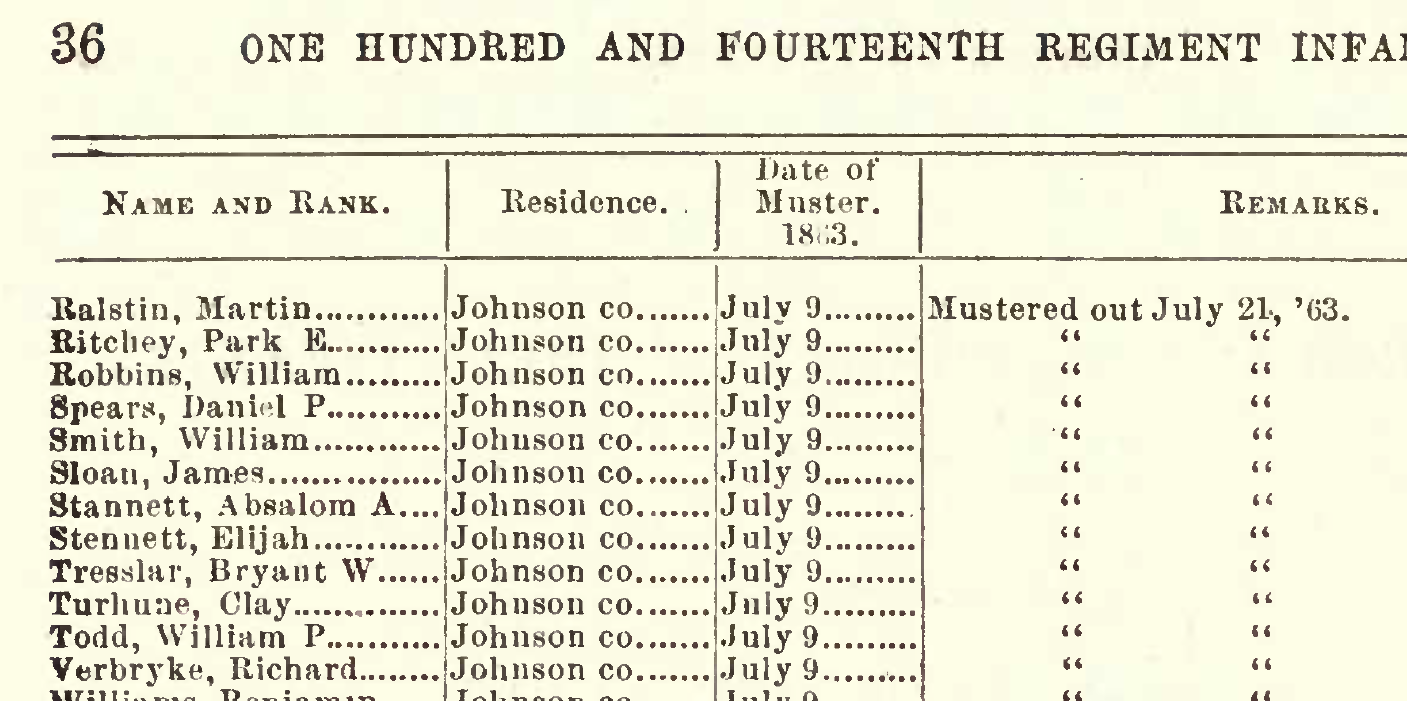
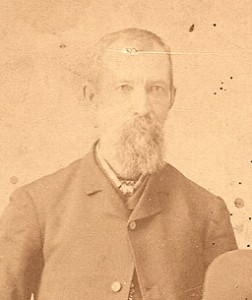 James Woodrum (1839-1872) (2nd great grandfather): (listed as single here? ) He would have been 24 and married 3 years with a daughter. He and Emily Jane Baugher were married in Jun 1860, but Census records show them still living with their parents in August of that year. He lived in Coles County Illinois; his wife lived in Cumberland County, Illinois. — Or this James Woodrum is possibly his nephew? Either way this is only the registration for the draft.
James Woodrum (1839-1872) (2nd great grandfather): (listed as single here? ) He would have been 24 and married 3 years with a daughter. He and Emily Jane Baugher were married in Jun 1860, but Census records show them still living with their parents in August of that year. He lived in Coles County Illinois; his wife lived in Cumberland County, Illinois. — Or this James Woodrum is possibly his nephew? Either way this is only the registration for the draft.

William Clifford (1808-1877) (2nd great grandfather) according to His wife’s biography: “He was a young man of considerable prominence having…been a Captain of militia in the “Keystone State.” prior to his marriage in 1844. He would have been age 53-57 in Westmoreland, Pennsylvania, during the Civil War.
–On my husband’s side of the family, his maternal grandmother’s ancestors were more recent German immigrants from the Ukraine or “Little Russia” His maternal grandfather was adopted. Many of his ancestors were from Canada, but some do go back to New England. His father’s side were all French Canadian, some have gone back and forth across the border at various times. I did find that my husband’s 3rd great-grandfather, Frederick Bresette, served in the Civil War:
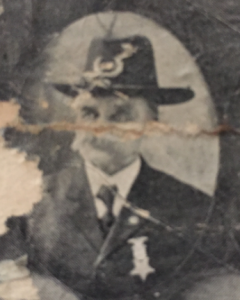 Frederick Bresette (1845-!924) served as a private in Company B & C, Vermont 9th Infantry Regiment. He enlisted on 22 Dec 1863 and was mustered out on 1 Dec 1865.
Frederick Bresette (1845-!924) served as a private in Company B & C, Vermont 9th Infantry Regiment. He enlisted on 22 Dec 1863 and was mustered out on 1 Dec 1865.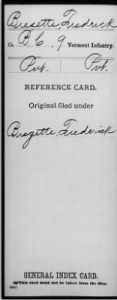

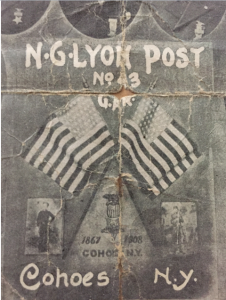

On Ed’s maternal grandfather’s side, His infamous biological 3rd great-grandfather, Napoleon Bonaparte Rand, appears to have been a prospector/miner in California and Oregon during the Civil War. His wife’s (Phoebe Mitchell”s) father, however, appears to have served:
Samuel C. Mitchell (1830-?) Enlisted in Company Battery G, Rhode Island Company G, 1st Light Artillery Battery on 02 Dec 1861. Mustered out on 08 Dec 1863. Transferred to Company H, U.S. Veteran Reserve Corps 1st Infantry Regiment on 08 Dec 1863. Mustered out on 18 Nov 1864.
